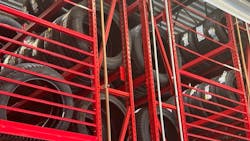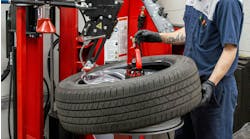While still negative on a year-over-year basis, our view is that retail sellout sales have begun to slowly inch closer to flat. June represents a seventh consecutive month of negative retail sellout, though the rate of decline slowed to just -0.5% for the month. And there are good reports in the regions. The Southwest region reported the strongest trends for the fourth straight month, up 2.5% year-over-year. Dealers in the Mid-Atlantic also reported positive gains, up 1.3% year-over year. The Northwest reported the softest numbers, falling an average 6.3% in June.
We would describe tire sellout as “becoming less bad.” In April dealer contacts reported sellout was down 4% year-over year. In May it was 2%, and in June, it was 0.5%.
The deferment cycle for auto repair seems to be driving some positive momentum. And while the overall inflationary environment has dampened retail sellout levels for the last year, dealers say some deflationary effects are working their way into the market, with some price cuts entering the picture. Given this, as well as the lapping of softer comparables in the second half of 2022, we would not be surprised to see sellout levels turn positive in July.
Looking to miles driven, trends strengthened for a fourth straight month. It’s the first occurrence of four straight months of positive trends since December 2021 to March 2022. Our miles driven momentum index registered a 3.5% year-over-year increase in June, beating the 3.2% year-over-year increase from May. And we can see that miles driven through the week of July 4th grew 5.1%.
Given these improvements in our miles driven index, we believe the tire replacement industry is beginning to see some positive tailwinds which have been largely absent thus far in 2023.
Another good sign is that raw material costs have continued to decrease. The basket of raw materials needed to build a basic replacement tire have fallen 17% year-over-year as of June, and slipped 1.9% from the prior month.
Improvement in demand
Dealers indicate consumer demand for passenger and light truck replacement tires turned positive on a net basis, compared to June 2022 numbers. Eleven percent of our dealer contacts saw positive demand trends in June, a sequential step up from the -83% and -43% reported in April and May, respectively. And for the second straight month, dealers tell us the consumer deferment cycle has begun to shift towards the positive end of the spectrum.
While this theme, driven by the overall inflationary environment, has served as a governor to demand trends for several months, it appears the pendulum has begun to swing in the other direction, driving higher volume of both repairs and tire sales. June marks the first month of net positive demand since our November 2022 survey.
Given the sequential improvement in sellout, a positive month of demand trends, improvements in vehicle miles traveled, and positive indicators regarding consumer deferment, we do see clearer skies on the horizon for the industry.
We are of the view that volumes in the long run will become aligned with the current level of GDP growth. While recessionary fears still loom, we proceed with caution in our view that GDP can remain positive and thus drive positive retail momentum in the months ahead.
Tier-two loses ground
Tier-one tires were the most in-demand from consumers during June, marking three straight months of sequential improvement. Dealers say as the consumer deferment cycle has begun to shift positively, consumers are opting for more premium tires. And while tier-one tires took the top spot in our rankings, tier-three brands were the second most in-demand for a second month in a row. Tier-two demand greatly softened, falling from the most in demand a month ago to the least demand in June. It’s a stark contrast from trends a year ago, when tier-two tires led the way for both May and June.
We note this is different from our historical tire tier rankings, as tier-two brands have ranked the highest over the previous one-, three- and 10-year periods. But in the current environment some consumers are opting for premium tier-one brands, while more consumers are opting for low-cost alternatives rather than the tier-two options.
When examining the landscape from a longer-term view, we continue to believe the pricing environment in North America will remain rational and in line with raw material costs. Dealers and wholesalers are being tactical with their approach. Downstream players have been directing orders in a way to capitalize on pricing spreads in the market.





